Classic Studies on John Knox (15 vols.)
Digital Logos Edition
Overview
During one of the most politically and religiously volatile periods in Scottish history, John Knox stood as a pillar of the Protestant faith. As leader of the Scottish Reformation, Knox was one of the most respected and influential men of his time. After converting to Protestantism, likely due to the influence of George Wishart—Knox passionately spoke out against Catholicism, and the divisions his teachings created remained a powerful source of tension centuries later.
In 1546, Knox was taken prisoner by French forces and eventually exiled to England, where he worked his way to the rank of royal chaplain. When Roman Catholicism re-emerged with the transition in royalty, Knox moved to Geneva, where he met John Calvin. Calvin influenced Knox’s theology and his understanding of church leadership structures. When Knox returned to Scotland, he led the movement that changed the religious landscape of the country forever: the Scottish Reformation. With five other leaders of the Reformation, Knox wrote the Scottish Confession of Faith and established the Reformed Presbyterian church known as the Church of Scotland, or the Kirk.
With the Logos edition of Classic Studies on John Knox, these interrelated texts automatically sync with your Logos library, allowing you to cross-reference them and study this influential leader like never before. All references to Scripture are tagged and appear in your favorite translations on mouseover. Read Classic Studies on John Knox on your mobile device to keep this model of powerful leadership with you wherever you go.

Key Features
- 15 different angles to explore the life of John Knox
- The confession of faith John Knox wrote to establish the Church of Scotland in court
- In-depth analysis of the ideas that changed the course of Scotland’s history
- A biography of John Knox written for adolescents
Individual Titles
- John Knox: A Biography, vol. 1 by Peter H. Brown
- John Knox: A Biography, vol. 2 by Peter H. Brown
- John Knox: The Hero of the Scottish Reformation by Henry Cowan
- The Date of Knox’s Birth by David H. Fleming
- John Knox: A Criticism and an Appreciation by John Glasse
- John Knox and John Knox’s House by Charles J. Guthrie
- John Knox by Marion Harland
- John Knox by Alexander T. Innes
- The Confessions of Faith and the Books of Discipline of the Church of Scotland
- John Knox and the Reformation by Andrew Lang
- John Knox and the Church of England by Peter Lorimer
- The Life of John Knox by Thomas M’Crie
- John Knox: His Ideas and Ideals by James Stalker
- John Knox by William M. Taylor
- John Knox by Julia M. Wright
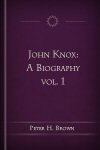
This biography was based upon the best information available—constructed with the help of Scottish scholars and intense personal research. It includes detailed illustrations of key places.
Peter Hume Brown (1849–1918) was the first professor of Scottish history at Edinburgh University. He had a key role in establishing the academic worth of Scottish history.
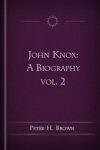
John Knox: A Biography, vol. 2
- Author: Peter H. Brown
- Publisher: Adam and Charles Black
- Publication Date: 1895
- Pages: 334
This biography was based upon the best information available, and constructed with the help of Scottish scholars and personal research. It includes detailed illustrations of key places.
Peter Hume Brown (1849–1918) was the first professor of Scottish history at Edinburgh University. He held a key role in establishing the academic worth of Scottish history.

John Knox: The Hero of the Scottish Reformation
- Author: Henry Cowan
- Publisher: G. P. Putnam’s Sons
- Publication Date: 1905
- Pages: 404

The Date of Knox’s Birth
- Author: Andrew Lang, David H. Fleming, and Henry Cowan
- Publisher: Presbyterian Historical Society
- Publication Date: 1905
- Pages: 468
This brief article, composed of letters by several biographers, brings to light the ambiguity of the year of Knox’s birth, and the possibility that previous biographers confused the Reformer with another man named John Knox.
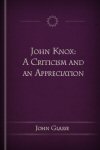
John Knox: A Criticism and an Appreciation
- Author: John Glasse
- Publisher: Adam and Charles Black
- Publication Date: 1905
- Pages: 194
This text was based largely upon John Knox’s own writings with the aid of biographical texts.
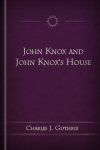
John Knox and John Knox’s House
- Author: Charles J. Guthrie
- Publisher: Oliphant, Anderson & Ferrier
- Publication Date: 1896
- Pages: 140
This book divulges the historical and architectural significance of John Knox’s house, and explores the house in relation to his work and his life. It includes 90 illustrations
Lord Charles John Guthrie (1849–1920) was a lawyer who served as a Queen’s council, a judge of the Court of Session, and lord advocate. He was also a member of the Royal Commissions on Historical Monuments in Scotland, and served as chairman of the Houseletting Commission.

John Knox
- Author: Marion Harland
- Publisher: G. P. Putnam’s Sons
- Publication Date: 1900
- Pages: 270
This text looks at John Knox’s personal and public life in relation to the timeline of the Reformation. It includes illustrations of key people and places.
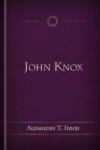
John Knox
- Author: Alexander T. Innes
- Publisher: Oliphant, Anderson & Ferrier
- Publication Date: 1896
- Pages: 150
This book looks at John Knox’s life from different angles, examining both his public and his private life.
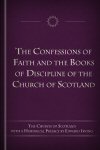
The Confessions of Faith and the Books of Discipline of the Church of Scotland
- Author: Church of Scotland
- Publisher: Baldwin and Cradock
- Publication Date: 1831
- Pages: 256
Engage the key confessional literature of the Church of Scotland with this collection of church documents. This book includes a historical overview by Edward Irving.
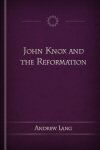
John Knox and the Reformation
- Author: Andrew Lang
- Publisher: Longman
- Publication Date: 1905
- Pages: 281
This biography provides a holistic view of Knox’s colorful character in addition to a study of his work and influence on Scotland. It also includes several illustrations.
Andrew Lang (1844–1912) was a Scottish writer and critic, most known for his writings on folklore, mythology, and religion. Throughout his life he remained an avid writer, and his 12 fairy books remain his most famous works.

John Knox and the Church of England
- Author: Peter Lorimer
- Publisher: Henry S. King & Co.
- Publication Date: 1875
- Pages: 317
This text contains a number of previously unpublished papers written by John Knox, which provide a new lens to view his life through.
Peter Lorimer (1812–1879) served for several years as an ordained minister in London before he was appointed professor of theology at the English Presbyterian College. In 1857, the college of New Jersey conferred on him an honorary Doctor of Divinity. In 1878, he became the English Presbyterian College’s first principal. He is the author of The Scottish Reformation: A Historical Sketch.

The Life of John Knox
- Author: Thomas M’Crie
- Publisher: Presbyterian Board of Publication
- Publication Date: 1818
- Pages: 579
This thorough biography was compiled using many sources, including a number of Knox’s own letters. The text also includes several illustrations, an index, an appendix, notes, and a supplement.
Thomas M’Crie (1772–1835) was educated at the University of Edinburgh before studying under Archibald Bruce. M’Crie was ordained in 1796 before spending the remainder of his life in ministry. His works include Lectures on the Book of Esther and The Early Years of John Calvin.

John Knox: His Ideas and Ideals
- Author: James Stalker
- Publisher: A. C. Armstrong and Son
- Publication Date: 1905
- Pages: 248
This text builds upon the works of M’Crie, Brown, Innes, Taylor, and others to present a more accessible representation of John Knox’s life.
James M. Stalker (1848–1927) was a powerful Scottish preacher, professor, and author. As a young man, he was influenced by the teachings of Dwight L. Moody. He wrote several books including The Trial and Death of Jesus Christ, The Seven Deadly Sins, and The Life of St. Paul
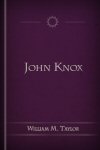
John Knox
- Author: William M. Taylor
- Publisher: Hodder and Stoughton
- Publication Date: 1884
- Pages: 211
This texts draws from the works of Peter Lorimer and others to provide a concise biography.
William Mackergo Taylor (1829–1895) studied at the University of Glasgow and the divinity hall of the United Presbyterian Church in Edinburgh. He was a pastor in Britain until 1872, when he moved to the United States and served as pastor of the Broadway Tabernacle in New York. He had a stroke in 1893 which left him paralyzed, forcing him to retire from preaching. His works include a biography of Matthew Dickie, The Scottish Pulpit from the Reformation to the Present Day, and a number of popular biographical sermons on Joseph, Moses, David, Elijah, Daniel, and Paul.

John Knox
- Author: Julia M. Wright
- Publisher: Presbyterian Committee of Publication
- Publication Date: 1870
- Pages: 64
This biography was written to convey the importance of John Knox to an adolescent audience.
Product Details
- Title: Classic Studies on John Knox
- Volumes: 15
- Pages: 4,268